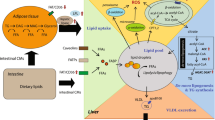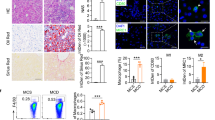Abstract
The reported data indicate that oleic acid (OA) decreases cholesterol absorption. To explore the underlying mechanisms, the effects of OA on the expression of cholesterol transport-related proteins (NPC1L1, ABCG5/8, ACAT2, MTP) and the unfolded protein response (UPR) pathway were studied in CaCo-2 enterocytes by incubating CaCo-2 cells with taurocholate micelles or taurocholate micelles containing different concentrations of OA (0.25–1.0 mM). We show that OA effectively induces XBP1 mRNA splicing, a key component of the UPR signaling, and the expression of BiP and mature ATF6 proteins in a concentration-dependent manner, leading to the induction of endoplasmic reticulum (ER) stress and activation of the UPR. Interestingly, OA decreases NPC1L1 expression in a dose-dependent manner while it has no effects on ABCG5 and MTP mRNA level or SREBP-2, ABCG8, and ACAT2 protein level. In CaCo-2 cells treated with 1.0 mM OA, both the NPC1L1 mRNA level and the NPC1L1 protein expression in brush-border membrane fractions were decreased by 39% and 37%, respectively (P < 0.01). A dose of 1 mM dithiothreitol (DTT), a positive control for ER stress induction, also decreases NPC1L1 mRNA and protein expression by 27% and 23%, respectively (P < 0.05). Furthermore, 4-phenyl-butyric acid, an UPR inhibitor, blocks OA- and DTT-induced reduction on NPC1L1 mRNA and protein levels. The results suggest that OA down-regulates NPC1L1 mRNA and protein expression via the induction of the UPR, which may play an important role in reducing intestinal cholesterol absorption.







Similar content being viewed by others
References
Alrefai WA, Annaba F, Sarwar Z, Dwivedi A, Saksena S, Singla A, Dudeja PK, Gill RK (2007) Modulation of human Niemann-Pick C1-like 1 gene expression by sterol: role of sterol regulatory element binding protein 2. Am J Physiol Gastrointest Liver Physiol 292:G369–G376
Altmann SW, Davis HR, Zhu LJ, Yao X, Hoos LM, Tetzloff G, Iyer SP, Maguire M, Golovko A, Zeng M, Wang L, Murgolo N, Graziano MP (2004) Niemann-Pick C1 Like 1 protein is critical for intestinal cholesterol absorption. Science 303:1201–1204
Berge KE, Tian H, Graf GA, Yu L, Grishin NV, Schultz J, Kwiterovich P, Shan B, Barnes R, Hobbs HH (2000) Accumulation of dietary cholesterol in sitosterolemia caused by mutations in adjacent ABC transporters. Science 290:1771–1775
Bretscher MS, Munro S (1993) Cholesterol and the Golgi apparatus. Science 261:1280–1281
Brown MS, Goldstein JL (2009) Cholesterol feedback: from Schoenheimer’s bottle to Scap’s MELADL. J Lipid Res 50:S15–S27
Calfon M, Zeng H, Urano F, Till JH, Hubbard SR, Harding HP, Clark SG, Ron D (2002) IRE1 couples endoplasmic reticulum load to secretory capacity by processing the XBP-1 mRNA. Nature 415:92–96
Colgan SM, Tang D, Werstuck GH, Austin RC (2007) Endoplasmic reticulum stress causes the activation of sterol regulatory element binding protein-2. Int J Biochem Cell Biol 39:1843–1851
Davis HR, Veltri EP (2007) Zetia: inhibition of Niemann-Pick C1 Like 1 (NPC1L1) to reduce intestinal cholesterol absorption and treat hyperlipidemia. J Atheroscler Thromb 14:99–108
Davis HR, Zhu LJ, Hoos LM, Tetzloff G, Maguire M, Liu J, Yao X, Iyer SP, Lam MH, Lund EG, Detmers PA, Graziano MP, Altmann SW (2004) Niemann-Pick C1 Like 1 (NPC1L1) is the intestinal phytosterol and cholesterol transporter and a key modulator of whole-body cholesterol homeostasis. J Biol Chem 279:33586–33592
Davies JP, Levy B, Ioannou YA (2000) Evidence for a Niemann-Pick C (NPC) gene family: identification and characterization of NPC1L1. Genomics 65:137–145
Feng B, Yao PM, Li YK, Devlin CM, Zhang DJ, Harding HP, Sweeny M, Rong JX, Kuriakose G, Fisher EA, Marks AR, Ron D, Tabas I (2003) The endoplasmic reticulum is the site of cholesterol-induced cytotoxicity in macrophages. Nat Cell Biol 5:781–792
Field FJ, Born E, Mathur SN (1995) Triacylglycerol-rich lipoprotein cholesterol is derived from the plasma membrane in CaCo-2 cells. J Lipid Res 36:2651–2660
Field FJ, Born E, Murthy S, Mathur SN (2001) Regulation of sterol regulatory element-binding proteins by cholesterol flux in CaCo-2 cells. J Lipid Res 42:1687–1698
Field FJ, Watt K, Mathur SN (2007) Ezetimibe interferes with cholesterol trafficking from the plasma membrane to the endoplasmic reticulum in CaCo-2 cells. J Lipid Res 48:1735–1745
Fonollá J, López-Huertas E, Machado FJ, Molina D, Alvarez I, Mármol E, Navas M, Palacín E, García-Valls MJ, Remón B, Boza JJ, Marti JL (2009) Milk enriched with “healthy fatty acids” improves cardiovascular risk markers and nutritional status in human volunteers. Nutrition 25:408–414
Gill JM, Brown JC, Caslake MJ, Wright DM, Cooney J, Bedford D, Hughes DA, Stanley JC, Packard CJ (2003) Effects of dietary monounsaturated fatty acids on lipoprotein concentrations, compositions, and subfraction distributions and on VLDL apolipoprotein B kinetics: dose-dependent effects on LDL. Am J Clin Nutr 78:47–56
Gylling H, Miettinen TA (1995) The effect of cholesterol absorption inhibition on low density lipoprotein cholesterol level. Atherosclerosis 117:305–308
Harding HP, Zhang Y, Khersonsky S, Marciniak S, Scheuner D, Kaufman RJ, Javitt N, Chang YT, Ron D (2005) Bioactive small molecules reveal antagonism between the integrated stress response and sterol-regulated gene expression. Cell Metab 2:361–371
Hui DY, Howles PN (2005) Molecular mechanisms of cholesterol absorption and transport in the intestine. Semin Cell Dev Biol 16:183–192
Jakobsen CH, Størvold GL, Bremseth H, Follestad T, Sand K, Mack M, Olsen KS, Lundemo AG, Iversen JG, Krokan HE, Schønberg SA (2008) DHA induces ER stress and growth arrest in human colon cancer cells: associations with cholesterol and calcium homeostasis. J Lipid Res 49:2089–2100
Jayadev S, Linardic CM, Hannun YA (1994) Identification of arachidonic acid as a mediator of sphingomyelin hydrolysis in response to tumor necrosis factor alpha. J Biol Chem 269:5757–5763
Kris-Etherton PM, Pearson TA, Wan Y, Hargrove RL, Moriarty K, Fishell V, Etherton TD (1999) High-monounsaturated fatty acid diets lower both plasma cholesterol and triacylglycerol concentrations. Am J Clin Nutr 70:1009–1015
Lange Y, Swaisgood MH, Ramos BV, Steck TL (1989) Plasma membranes contain half the phospholipid and 90% of the cholesterol and sphingomyelin in cultured human fibroblasts. J Biol Chem 264:3786–3793
Mathur SN, Watt KR, Field FJ (2007) Regulation of intestinal NPC1L1 expression by dietary fish oil and docosahexaenoic acid. J Lipid Res 48:395–404
Mori K (2000) Tripartite management of unfolded proteins in the endoplasmic reticulum. Cell 101:451–454
Morris JA, Dorner AJ, Edwards CA, Hendershot LM, Kaufman RJ (1997) Immunoglobulin binding protein (BiP) function is required to protect cells from endoplasmic reticulum stress but is not required for the secretion of selective proteins. J Biol Chem 272:4327–4334
Ota T, Gayet C, Ginsberg HN (2008) Inhibition of apolipoprotein B100 secretion by lipid-induced hepatic endoplasmic reticulum stress in rodents. J Clin Invest 118:316–332
Ozcan U, Yilmaz E, Ozcan L, Furuhashi M, Vaillancourt E, Smith RO, Gorgun CZ, Hotamisligil GS (2006) Chemical chaperones reduce ER stress and restore glucose homeostasis in a mouse model of type 2 diabetes. Science 313:1137–1140
Parks JS, Crouse JR (1992) Reduction of cholesterol absorption by dietary oleinate and fish oil in African green monkeys. J Lipid Res 33:559–568
Patil C, Walter P (2001) Intracellular signaling from the endoplasmic reticulum to the nucleus: the unfolded protein response in yeast and mammals. Curr Opin Cell Biol 13:349–355
Repa JJ, Buhman KK, Farese RV, Dietschy JM, Turley SD (2004) ACAT2 deficiency limits cholesterol absorption in the cholesterol-fed mouse: impact on hepatic cholesterol homeostasis. Hepatology 40:1088–1097
Rivellese AA, Maffettone A, Vessby B, Uusitupa M, Hermansen K, Berglund L, Louheranta A, Meyer BJ, Riccardi G (2003) Effects of dietary saturated, monounsaturated and n−3 fatty acids on fasting lipoproteins, LDL size and post-prandial lipid metabolism in healthy subjects. Atherosclerosis 167:149–158
Robinson BS, Hii CS, Poulos A, Ferrante A (1997) Activation of neutral sphingomyelinase in human neutrophils by polyunsaturated fatty acids. Immunology 91:274–280
Sudhop T, Lutjohann D, Kodal A, Igel M, Tribble DL, Shah S, Perevozskaya I, von Bergmann K (2002) Inhibition of intestinal cholesterol absorption by ezetimibe in humans. Circulation 106:1943–1948
Waterman E, Lockwood B (2007) Active components and clinical applications of olive oil. Altern Med Rev 12:331–342
Wetterau JR, Lin MC, Jamil H (1997) Microsomal triglyceride transfer protein. Biochim Biophys Acta 1345:136–150
Wilson MD, Rudel LL (1994) Review of cholesterol absorption with emphasis on dietary and biliary cholesterol. J Lipid Res 35:943–955
Yoshida H, Matsui T, Yamamoto A, Okada T, Mori K (2001) XBP1 mRNA is induced by ATF6 and spliced by IRE1 in response to ER stress to produce a highly active transcription factor. Cell 107:881–891
Zeng L, Lu M, Mori K, Luo S, Lee AS, Zhu Y, Shyy JY (2004) ATF6 modulates SREBP2-mediated lipogenesis. EMBO J 23:950–958
Acknowledgments
This work was supported by Hubei Natural Science Foundation (2009).
Author information
Authors and Affiliations
Corresponding author
Rights and permissions
About this article
Cite this article
Chen, J., Li, Q., Zhang, Y. et al. Oleic acid decreases the expression of a cholesterol transport-related protein (NPC1L1) by the induction of endoplasmic reticulum stress in CaCo-2 cells. J Physiol Biochem 67, 153–163 (2011). https://doi.org/10.1007/s13105-010-0058-y
Received:
Accepted:
Published:
Issue Date:
DOI: https://doi.org/10.1007/s13105-010-0058-y




